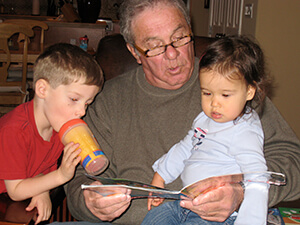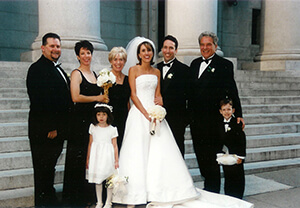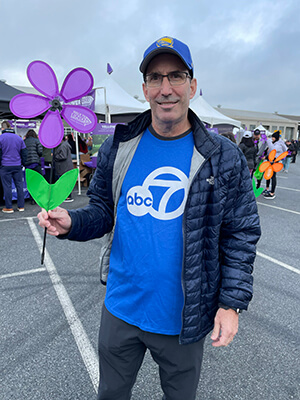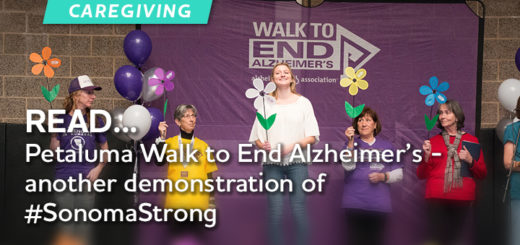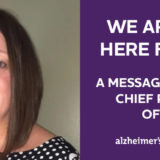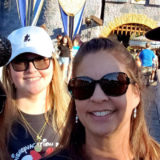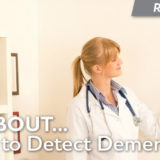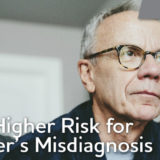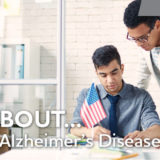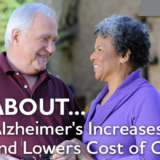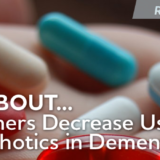Family history of dementia inspires one man to take action
Todd Farber has a family history of Alzheimer’s disease, having sadly lost three family members to dementia: his grandmother, his aunt and his father. Years after his father’s death, Todd found his way on to the Walk Committee for the Alzheimer’s Association Walk to End Alzheimer’s®. Todd shares the importance of volunteering and the steps he takes to reduce his risk of cognitive decline.
Everyone knows Herb
Todd Farber’s father, Herb, was born in Brooklyn, New York, but made a name for himself in the California Bay Area. Working in the TV industry during the 1970s, if you said the name “Herb” people knew who you were talking about. He was a progressive man who insisted on hiring the best candidate for the job no matter who they were.
“Looking back now, he was really progressive in terms of tolerance and equity,” said Todd. “There was a [public service announcement commercial] on TV about prejudice and I asked my dad, ‘Are we prejudice?’ and the ‘No!’ couldn’t have come out faster. He was progressive, accepting of people for who they were with no regard to anything other than their abilities and attitudes.”
Family history of dementia
Herb was no stranger to dementia as both his mother and his sister died with the disease. Herb’s partner, Betsy, was the first to recognize the signs in Herb and notified his family. “Betsy sounded the alarm,” said Todd. “At first he was diagnosed with [Mild Cognitive Impairment] (MCI) but quickly deteriorated and was later diagnosed with Lewy body dementia (LBD).”
Dementia with Lewy bodies (DLB) is a type of progressive dementia that leads to a decline in thinking, reasoning and independent function. Its features may include spontaneous changes in attention and alertness, recurrent visual hallucinations, REM sleep behavior disorder, and slow movement, tremors or rigidity.
“It’s really scary when you are more relieved that you get something as awful as Lewy body dementia because it’s quicker,” said Todd. “We went through our process of four to six years rapidly compared to eight to 12 years with other forms of dementia. All in all, I think he went into assisted living prob three years [after he was diagnosed]. He was in assisted living for just two years, and he passed away at 81.”
New treatments
At the time of Herb’s diagnosis there weren’t any treatments that could change the progression of the disease. However, this has changed. In 2021 the U.S. Food and Drug Administration (FDA) approved Aducanumab (Aduhelm®)) which was the first therapy to reduce cognitive and functional decline in people living with early Alzheimer’s.
Then, in early 2023, Lecanemab (Leqembi®) received FDA approval. Both of these treatments are anti-amyloid treatments. They work by attaching to and removing beta-amyloid, a protein that accumulates into plaques, from the brain. Each works differently and targets beta-amyloid at a different stage of plaque formation.
Todd is relieved to see advances being made, especially in ones that slow down progression. “Alzheimer’s is so final and that’s what is so exciting now with the new treatments,” said Todd. “When you’re talking about slowing down decline from some of these drugs. You can buy people [more] years, more family get-togethers, more holidays, more birthdays, more weddings and more time with grandchildren. It’s essential people know and find out early [so these drugs can] have an impact.”
Risk reduction habits
Growing evidence indicates that people can reduce their risk of cognitive decline by adopting key lifestyle habits. When possible, these habits can be combined to achieve maximum benefit for the brain and body. Knowing that he has a family history of the disease, Todd is focusing on what he can do to help reduce his risk of cognitive decline.
Todd spends his free time hiking in the hills around his house. He knows that exercise that elevates his heart rate will increase blood flow to the brain and body. He’s also learning Spanish and knows that education of any kind can positively impact memory.
“I’m lucky to live [where] there is open space and hills [within] walking distance from my house,” said Todd “I try to hike every day and get nature and elevation. Exercise and blood flow to the brain can help. I’m working to learn Spanish on Duolingo. Spanish is important in California to engage with our community but also learning new things keep my brain moving. It will help exercise my brain and keep any potential genetic issues I may have further down the line.”
Joining the committee
Despite knowing about the Alzheimer’s Association while his father was alive, Todd never utilized the services available to him. It wasn’t until his employer became a sponsor for Walk to End Alzheimer’s in San Francisco that Todd really got involved.
At first, Todd was comfortable to just make a donation each year to his company’s team. However, after attending his first Walk Todd knew he wanted to do more. Todd decided to volunteer and joined the Walk Committee.
Todd’s is part of the Executive Leadership Team whose job it is to recruit local companies and businesses to start teams and sponsor the event. “Our goal is to really use business executives’ sphere of influence to try and raise awareness,” said Todd “We want to bring other corporate partners to Walk and help fundraise and build a leadership team.”
Todd believes that if you have the capacity to volunteer you should. “[Volunteering] is a way to amplify your personal impact,” said Todd. “Being exposed and introduced to people that inspire you just adds positively to one’s life. We don’t get bombarded with positivity in our current society, you have to search it out. It’s a great way to meet people and when you surround yourself with people who are selfless it helps ground you.”
An inspiring event
Last year (2022) was Todd’s first year participating in the Walk. He was surprised to find the event to be so uplifting despite the topic being a sad one. While he was there, he saw his community come together in the hopes of making a difference for those living with the disease. He saw people celebrating life and the entire event inspired him.
“It’s the cow bells and everybody coming together,” said Todd. “It’s so positive, uplifting and so much fun. We’re in San Francisco and the Chinese dragon (traditional lion dance) was there. There was so much local pride. Being able to spend time with people, that human connection, a shared common experience.
“Coming out of the COVID-19 shell and doing something with the community again was very powerful. The event is something everyone should experience. Once you do, you’ll be compelled to get further involved.”
You can join Todd and his team, Herbie’s Love Bugs, at Walk to End Alzheimer’s in San Francisco on November 4.
San Francisco is the last Walk of the 2023 season in Northern California and Northern Nevada. Fundraising continues through December 31. Please consider making a donation to your local Walk at alz.org/walk.





